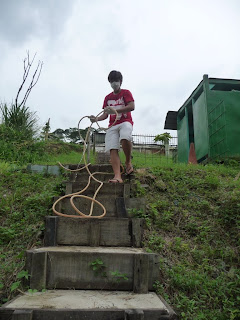Once the metal prototype was in place, we started the first run. This prototype was left running for 16 in total. 10 days anaerobic run and a 6 days aerobic run before we took the samples for testing. This second run was a lot smoother than our first run. By now, we have the necessary experience to conduct the experiment smoothly. The entire loading process went on without much of a hiccup.
Fig1. Preparing for the prototype run
Fig2. Loading the sludge into the digester
Fig3. Clearing the surrounding area
Fig4. Using water to rinse the system and surrounding
Following this, the gas test was conducted after ten days and these are the results obtained.
Fig5. Carbon dioxide drager tube reflecting a small amount of carbon dioxide present
Fig6. Hydrogen sulfide drager tube reflecting a hge amount of hydrogen sulfide (more than 60ppm)
Fig7. Methane drager tube shows slight color change, indicating presence of methane
Following the gas testing, we took a sample and headed down to Ensure Engineering's lab to conduct further test regarding the components in the digested sludge. The results are reflected in the final report.
 0
comments
Monday, December 28, 2009
0
comments
Monday, December 28, 2009



























